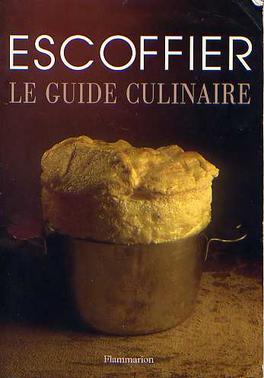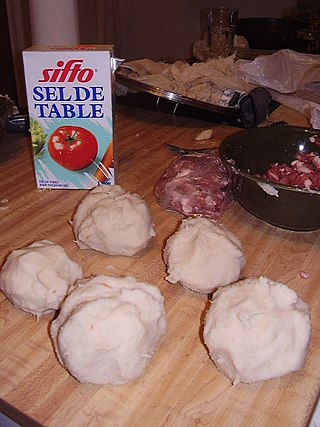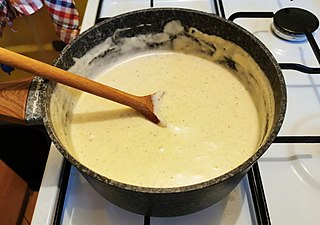
Seasoning is the process of supplementing food via herbs, spices, salts, and/or sugar, intended to enhance a particular flavour.

In cooking, a sauce is a liquid, cream, or semi-solid food, served on or used in preparing other foods. Most sauces are not normally consumed by themselves; they add flavor, moisture, and visual appeal to a dish. Sauce is a French word taken from the Latin salsa, meaning salted. Possibly the oldest recorded European sauce is garum, the fish sauce used by the Ancient Romans, while doubanjiang, the Chinese soy bean paste is mentioned in Rites of Zhou in the 3rd century BC.

Roux is a mixture of flour and fat cooked together and used to thicken sauces. Roux is typically made from equal parts of flour and fat by weight. The flour is added to the melted fat or oil on the stove top, blended until smooth, and cooked to the desired level of brownness. A roux can be white, blond (darker) or brown. Butter, bacon drippings or lard are commonly used fats. Roux is used as a thickening agent for gravy, sauces, soups and stews. It provides the base for a dish, and other ingredients are added after the roux is complete.

Chateaubriand is a dish that traditionally consists of a large front cut fillet of tenderloin grilled between two lesser pieces of meat that are discarded after cooking. While the term originally referred to the preparation of the dish, Auguste Escoffier named the specific front cut of the tenderloin the Chateaubriand.

Hollandaise sauce, meaning Dutch sauce in French, is a mixture of egg yolk, melted butter, and lemon juice. It is usually seasoned with salt, and either white pepper or cayenne pepper.

Le Guide Culinaire is Georges Auguste Escoffier's 1903 French restaurant cuisine cookbook, his first. It is regarded as a classic and still in print. Escoffier developed the recipes while working at the Savoy, Ritz and Carlton hotels from the late 1880s to the time of publication. The hotels and restaurants Escoffier worked in were on the cutting edge of modernity, doing away with many overwrought elements of the Victorian era while serving the elite of society.

Béarnaise sauce is a sauce made of butter, egg yolk, white-wine vinegar, and herbs. It is regarded as a "child" of hollandaise sauce. The difference is only in the flavoring: béarnaise uses shallot, black pepper, and tarragon, while hollandaise uses white pepper or a pinch of cayenne.

Gastrique is caramelized sugar, deglazed with vinegar or other sour liquids, used as a sweet and sour flavoring for sauces.

Lyonnaise potatoes – in French pommes de terre sautées à la lyonnaise – are potatoes, boiled and then sliced and shallow-fried, served together with fried onions.

Duchess potatoes consist of a purée of mashed potato, egg yolk, and butter, which is forced from a piping bag or hand-moulded into various shapes which are then baked in a high temperature oven until golden. They are typically seasoned similarly to mashed potatoes with, for example, salt, pepper, and nutmeg. They are a classic item of French cuisine, and are found in historic French cookbooks.

Albufera sauce is a daughter sauce of French cuisine. It is based on a Suprême sauce, which itself derives from the mother sauce velouté.

Compound butters are mixtures of butter and other ingredients used as a flavoring, in a fashion similar to a sauce.

Acadian cuisine comprises the traditional dishes of the Acadian people. It is primarily seen in the present-day cultural region of Acadia. Acadian cuisine has been influenced by the Deportation of the Acadians, proximity to the ocean, the Canadian winter, bad soil fertility, the cuisine of Quebec, American cuisine, and English cuisine, among other factors.

Soubise sauce is an onion sauce thickened with béchamel sauce, pounded cooked rice, or cream. It is generally served with meats, game, poultry and vegetables. It was formerly often used to coat meat. It is first documented in 1836. It has many variations, the simplest including just onions, butter, and cream.

Beurre maître d'hôtel, also referred to as maître d'hôtel butter, is a type of compound butter of French origin, prepared with butter, parsley, lemon juice, salt and pepper. It is a savory butter that is used on meats such as steak, fish, vegetables and other foods. It may be used in place of a sauce, and can significantly enhance a dish's flavor. Some variations with a sweet flavor exist. It is usually served cold as sliced disks on foods, and is sometimes served as a side condiment.

A Pozharsky cutlet is a breaded ground chicken or veal patty that is typical of Russian cuisine. A distinct feature of this cutlet is adding butter to minced meat, which results in an especially juicy and tender consistency. The dish was created in the beginning of the 19th century in Russia and later adopted by French haute cuisine.
Sauce bercy is a classic sauce of French cuisine. The main ingredients are fish stock, velouté sauce, white wine, shallots and butter.

Cardinal sauce is a classic French sauce, with a distinctive red colour coming from lobster butter and cayenne pepper.

In French cuisine, the mother sauces, also known as grandes sauces in French, are a group of sauces upon which many other sauces – "daughter sauces" or petites sauces – are based. Different sets and classifications of mother sauces have been proposed since at least the early 19th century.


















